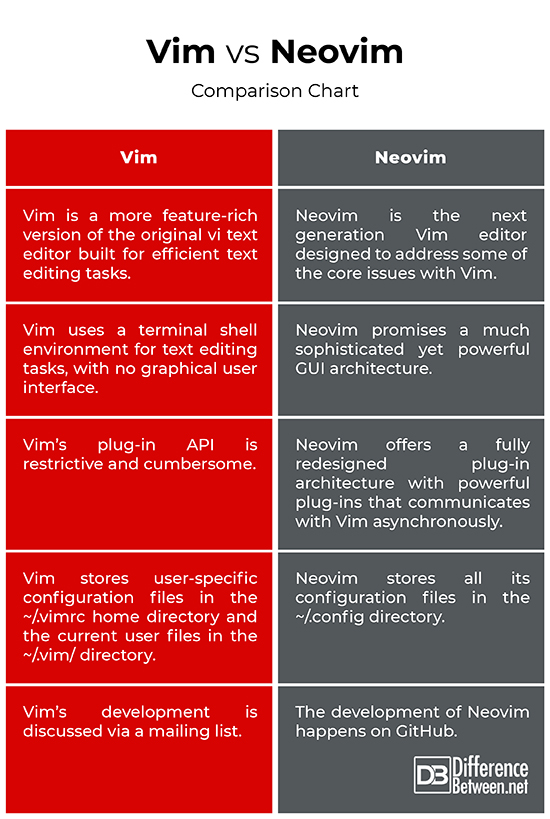Difference Between Vim and Neovim
The Bram Moolenaar’s Vim is a highly-configurable, community-driven text editor that’s been loved by programmers since ages. But conventional wisdom states that Vim has a steep learning curve and it has its fair share of indiscrepancies. To overcome the issues with Vim, Neovim was developed to expand on the core functionalities of Vim and for users who want to make the best out of vim. We pit the two text editors against each other to see which one is better than the other.

What is Vim?
Vim is a powerful, highly-configurable text editor for Unix systems and a more feature-rich version of the original vi text editor, hence the name, ‘Vi IMproved’. Vim is a free, open source text editor built for writing notes, reminders, emails, and so on. Vim provides multiple ways to accomplish any given task and you can do almost anything with the keyboard, and on top of it all, it does everything much faster. Vim, similar to the classic Vi, is a screen-oriented editor designed to make text editing more convenient and efficient than ever. Although, mostly used for editing source code files, Vim is great for writing code and maintaining configuration files, and you can do so much more with lesser keystrokes. It is very sophisticated, allowing users to write their own scripts (Scripting) – a feature released with the fifth iteration of Vim expanding its functionality. Vim works in two modes: Command mode and Input mode.

What is Neovim?
Neovim is a community driven open source project and a forked version of the Vim text editor built to make Vim easier to maintain for its core developers. It is an enhanced out of the box version of the Vim text editor or you can say, it is a more simplified Vim which makes integrations much easier than with Vim. Vim is already the most loved text editor and the programmer’s choice of text editor. Think of Neovim as the next generation Vim editor designed to address some of the core issues with its predecessor. For one, writing plug-ins was quite tough and Vim is not very optimized for modern systems. So, Neovim solves the problems you’ve had with Vim. Neovim makes the best of Vim with completely re-designed plug-in architecture, better GUI ecosystem, first-class support for embedding, and more.
Difference between Vim and Neovim
Terminology
– Vim, short for “Vi IMproved”, is a more powerful, enhanced version of the classic vi text editor built to take text editing a level up. It is a sophisticated text editor which is ideal for editing source code files and maintaining configuration files, and so much more. Neovim, on the other hand, is a complete revamped, out of the box version of Vim built to make Vim easier to maintain for its core developers. Neovim is for users who want to make the best of Vim, while still working with the core features of Vim.
Directory
– Both follow different conventions on where to store their configuration files. Vim likes to store current user files in the ~/.vim/ directory and the user-specific configuration files in the ~/.vimrc home directory. Your home directory is specified with $HOME. Neovim, on the other hand, adheres to the XDG base directory specification and stores all its configuration files in the ~/.config directory. The Neovim configuration is stored inside the ~/.config/nvim directory.
Plug-In System
– In many ways, Vim and Neovim are interchangeable, but the one area where Neovim significantly outsmarts Vim is its plug-in management. Vim’s plug-in API is restrictive and cumbersome. Neovim is a complete rework of the Vim text editor with a fully redesigned yet sophisticated plug-in architecture that has more powerful plug-ins than before. In addition, the remote plug-in architecture of Neovim enables you to extend the functionality of the editor by making remote procedure calls (RPCs) through just any programming language, and they run asynchronously. Most plug-ins written for Vim also work just fine in Neovim.
GUI Architecture
– Vim uses a terminal shell environment for text editing tasks, with no graphical user interface (GUI); instead, Vim has a textual user interface (or TUI). If you’re comfortable working with the command line all day long, Vim feels just as natural. Neovim, on the other hand, banks on its feature-rich, powerful GUI architecture, providing a bridge into the world of Vim. Oni, the GUI for Neovim, allows you to leverage the power of modal editing without wanting to have a terminal user interface. This brings in more stability and improved performance and makes the code easier to maintain.
Vim vs. Neovim: Comparison Chart

Summary
So, in a nutshell, Neovim is a forked, more feature-rich version of the Vim text editor developed to make Vim simpler, flexible, and easier to maintain. Neovim is for users who want to make the best of Vim through a new plug-in system, better GUI architecture, first-class embedding support, and more. Although, Vim and Neovim are interchangeable in many ways, Neovim makes it easier to add new features and create plug-ins and what not, thereby making the codebase of Vim more maintainable. In addition, Vim script works well in Neovim, so many plug-ins written specifically for the Vim text editor will also work in Neovim. In short, Neovim has turned Vim into a full-fledge development environment.
- Difference Between Caucus and Primary - June 18, 2024
- Difference Between PPO and POS - May 30, 2024
- Difference Between RFID and NFC - May 28, 2024
Search DifferenceBetween.net :
Leave a Response
References :
[0]Neil, Drew. Practical Vim: Edit Text at the Speed of Thought. North Carolina, United States: The Pragmatic Bookshelf, 2015. Print
[1]Neil, Drew. Modern Vim: Craft Your Development Environment with Vim 8 and Neovim. North Carolina, United States: The Pragmatic Bookshelf, 2018. Print
[2]Mayo, Adrian. Mac OS X UNIX: 101 Byte-sized Projects. California, United States: Peachpit Press, 2006. Print
[3]Osipov, Ruslan. Mastering Vim: Build a software development environment with Vim and Neovim. Birmingham, United Kingdom: Packt Publishing, 2018. Print
[4]Dandamudi, Sivarama P. Guide to Assembly Language Programming in Linux, Volume 1. Berlin, Germany: Springer, 2005. Print
[5]Image credit: https://pixabay.com/da/vectors/teksteditor-vim-software-tema-logo-27620/
[6]Image credit: https://upload.wikimedia.org/wikipedia/commons/thumb/4/4f/Neovim-logo.svg/500px-Neovim-logo.svg.png
